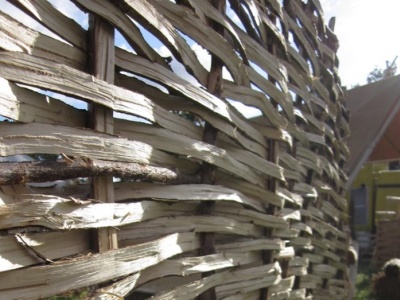
Hazel Hurdle Making
- The Green Wood Centre
- 27 Apr 2024

The current state of our woodlands
For centuries, Sussex woodlands were a part of people’s lives, for both industry and pleasure. Whilst we still have beautiful woods and trees in Sussex, today nearly 60 per cent of woods in the Low Weald are now unmanaged and absent of wildlife.

The Lost Woods area stretches from Pulborough in West Sussex to the fringes of Lewes in East Sussex. This landscape is dominated by agriculture and the remaining woods are often small and in poor condition. They are also less resilient to impacts of the changing climate and other adverse factors, resulting in vulnerable habitats for wildlife. Tree cover in the Low Weald area is just 14 per cent, compared to 22.8 per cent in the South Downs and 24.8 per cent in the High Weald area to the North. These are the ‘lost’ woods that we want to restore.

Photo credit: Ed Goodall
What are we going to do?
The “Lost Woods of Low Weald and Downs” project is aiming to breathe new life into badly fragmented and degraded woodland across 314km2 of Sussex – by reconnecting local people to their environment.
At risk woodlands will flourish thanks to this pioneering project being delivered by the Woodland Trust, Small Woods, Action in rural Sussex and Sussex Wildlife Trust with funding from the National Lottery Heritage Fund (NLHF), and the support of players of the National Lottery, for which we are very thankful!
We will enhance access to woodlands through events and volunteering and create a “woodland culture” by providing education, skills and opportunities through a programme of formal training and support for owners, managers and contractors. Ultimately, we envisage creating a resource of skilled individuals to manage the woodlands into the future and establish a new generation of woodland champions.
“The ultimate aim is to help the woods be more resilient so that they are no longer “lost woods,” but loved woods”

How can you help?
We need to raise £23,800 as our part of necessary match funding.
Please consider donating to Small Woods Association and helping us reach this target - at a time when the natural world is in desperate need, this is a chance to make a lasting difference to our beloved countryside and reap the benefits on a local level.
How to donate
Click here for our JustGiving page
Why do woodlands need management?
Our woodlands once covered a vast area of the UK, often merging and complimenting other habitats and allowing for species to migrate between them. The natural processes which allowed these woodlands to maintain their essential balance included:
- Areas being kept open by large herbivores grazing
- Local water levels being raised by beavers
- Areas blowing over allowing space for wildflowers and shrubs to grow
- Dead and decaying wood providing habitat for insects
Sadly, this balance has been thrown out by due to the pressures of historical development and the planting of trees which don’t support wildlife.This has led to a stark decline in the wildlife which support the natural processes that allow a woodland to manage itself. Invasive species, disease and prioritising economic over ecological management have also played a huge part.

A woodland choked by bramble bushes
What can help?
Active management is designed to mimic the processes that used to occur naturally in our woodlands. These include:
- Tree felling (thinning areas where trees are competing)
- Coppicing (felling trees at the base and allowing them to regrow)
- Creating open areas
- Allowing for dead wood
- Planting new trees
These management techniques create a varied structure – light and shade, wet areas and dry – that can support a far larger number of woodland species. This improves biodiversity and helps the woodland to flourish, becoming balanced and sustainable once again.

What is Small Wood’s role?
Our part of delivering the project will see us work across the Low Weald and Downs with woodland owners, managers and contractors to revive and restore woods - introducing training on ways of managing woodlands, restoring biodiversity, expanding woodland habitat and forging greater connectivity of woodlands across the landscape.

One cause of significant woodland loss and consequent impact on biodiversity value is the decline in coppice, the traditional way in which British woodlands have been managed for thousands of years We will be work with woodland owners and managers to restore coppice woodlands - providing support through various platforms including coppice camp, national apprenticeships, training courses and restoration.